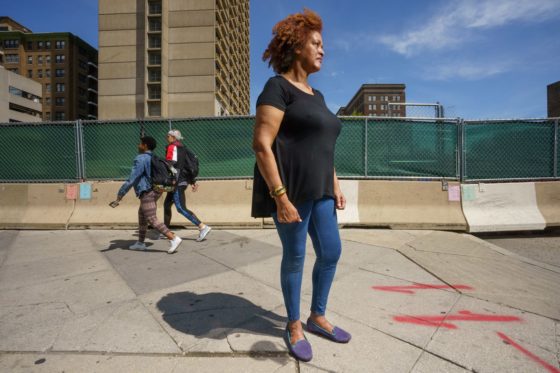
The essence of her “Disappearing Blackness” campaign can be summed up in a photo that activist Faye Anderson saw online:
There was Kenny Gamble outside Hitsville U.S.A., the Motown studio Berry Gordy founded in Detroit. But to do that here, on Broad Street, outside the very studio Gamble founded — Philadelphia International Records — would be impossible.
“That’s because all that is left of it right now is a hole in the ground,” Anderson said.
As a “citizen preservationist,” Anderson has posted photos to Twitter showing empty spots where African American historical markers have been plucked from sidewalks in gentrifying neighborhoods. She’s protested the demolitions on Jewelers Row and of Abolition Hall. She’s testified in front of City Council.
And on Saturday, Anderson, a public policy consultant, will co-host a panel, “Gentrification, Resistance, and Cultural Preservation,” as part of Common Field Convening, a national network of visual arts organizations meeting here this weekend.
With presentations by storyteller Denise Valentine, visual artist Sherman Fleming, and Arielle Julia Brown of the Penn and Slavery Project at the University of Pennsylvania, the panel will focus on using art for social change.
#BossPBS Henry Minton was an elite caterer. In his Philadelphia residence, he entertained Frederick Douglass and gave John Brown a place to stay shortly before Harper’s Ferry raid.
— Faye M. Anderson (@andersonatlarge) April 24, 2019
On April 12, #PhilaHIstorical Commission doomed building to demolition. #400Years #400YearsPHL pic.twitter.com/EDJpH1QFxX
Anderson, director of All That Philly Jazz, a public history project, began using “Disappearing Blackness” — a hashtag coined by Black and Brown Workers Cooperative activist Abdul-Aliy A. Muhammad — and speeches and protests to call attention to “the erasure” of African American culture and history in a rapidly changing city.
However, her efforts to stop the removal of historical markers is part of her work as chair of the Historical Marker Monitoring Committee of the Avenging the Ancestors Coalition(ATAC), which fought to successfully have recognized that George Washington held enslaved African Americans at the President’s House.
Earlier this week, Anderson visited the fenced-off empty lots where Gamble and Leon Huff created the Sound of Philadelphia, across from the Kimmel Center.
Anderson stopped a man and asked if he knew about the building that once stood there. The man paused, but said he didn’t know.
“You see, this is what happens,” Anderson said. “The physical memories of our history get torn down and forgotten.”
Fighting demolition with nominations
Anderson testified this month at a Historical Commission hearing to support the nomination of the Henry Minton House, part of the old 12th Street Gym, to the city’s historic register. Minton, a successful black caterer, restaurant owner, and abolitionist, hosted meetings at the house built in 1818 that included abolitionists Frederick Douglass and John Brown.
The application by architectural preservationist Oscar Beisert included that in 1859, Minton entertained Brown “‘with bed and board’ when Brown was passing through Philadelphia shortly before his raid upon Harper’s Ferry.”
“The Historical Commission concluded that the property did not satisfy the statutory criteria for designation because the structure as it exists today is unrelated to Mr. Minton,” Paul Chrystie, spokesman for the city’s Office of Housing and Community Development, wrote in an email.
He added, “The Historical Commission has designated dozens of sites that reflect African American history in Philadelphia, and has spent the better part of a decade, including in court, fighting to preserve the Robert Purvis house from demolition by neglect.” (The Mount Vernon Street house is the only surviving building associated with Purvis, often called the president of the Underground Railroad.)
Matthew McClure, the lawyer representing John Usdan of Midwood Investment & Development LLC, which purchased the 12th Street Gym site, said some preservationists don’t always have pure motives.
He believes that Beisert, of the preservationist group the Keeping Society, only researched filing a historic designation nomination after learning about the planned development.
“Sometimes the preservationists are using the historic designation as a sword rather than a shield,” McClure said. “If all you’re doing is regulation against demolition without any plans or resources for rehabbing a historic site, especially in economically challenged areas, you’re regulating without truly preserving.”
Beisert denied the accusation.
As for the space on Broad Street, now empty for almost six years, Carl Dranoff has plans to develop a residential tower with 107 units.
“As we’ve done with nearly every Dranoff project in the past, we plan to recognize the rich history of the Broad and Spruce site as the former home of Philadelphia International Records,” said Dranoff in a statement. “Our residential project at Broad and Spruce will be a transformative addition to the Avenue of the Arts.”
‘The least we can do’
Sometimes Anderson is able to advocate by public shaming: like when she showed how two markers, one showing where W.E. B. DuBois once lived at Sixth and Rodman Streets, and another where white slave traders auctioned off captured Africans outside the old London Coffee House on Market Street, had been “disrespected by having had, respectively, a trash can and a UPS drop box chained to the markers’ poles.” Her very public spotlight got the receptacles moved.
Recently, she was part of a protest of plans to demolish buildings on Jewelers Row, the 700 block of Sansom Street.
The @PhillyTrib, oldest continuously published African American newspaper in U.S., was originally located on Jewelers Row. The first edition was published in 1884 at 725 Sansom St.#SaveJewelersRow @MichaelCoard @bobbibooker @IrvRandolph @FreeJNmitchell #400YearsPHL #400Years pic.twitter.com/vbizsFOY93
— Faye M. Anderson (@andersonatlarge) April 19, 2019
The first office of the Philadelphia Tribune, the nation’s oldest continuously operated black-owned newspaper, had been located in that block. Beisert said the block was first famous for its many print shops that also published the Saturday Evening Post and Ladies’ Home Journal.
At an April 15 City Council hearing on Mayor Jim Kenney’s proposed budget for next year, Anderson testified about Philadelphia’s “development boom, leading to a demolition crisis,” where buildings such as Union Baptist Church, where Marian Anderson learned to sing, and Philadelphia International Records and the Royal Theater are now “erased from public memory.”
For Anderson, her motivation is constant. “I tell everyone this: ‘The ancestors have done the heavy lifting, the least we can do is preserve their stories.’”
This article was first found at the Inquirer, it was written by Valerie Russ






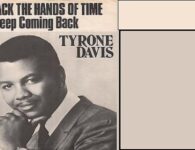


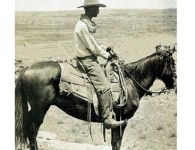

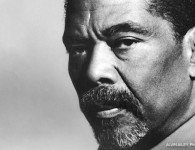



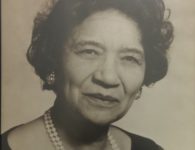
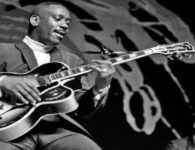
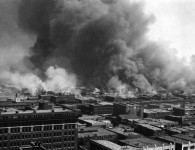
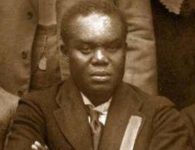

1 Comment
Those buildings in the Diamond District are beautiful. Leave them be, history is important !